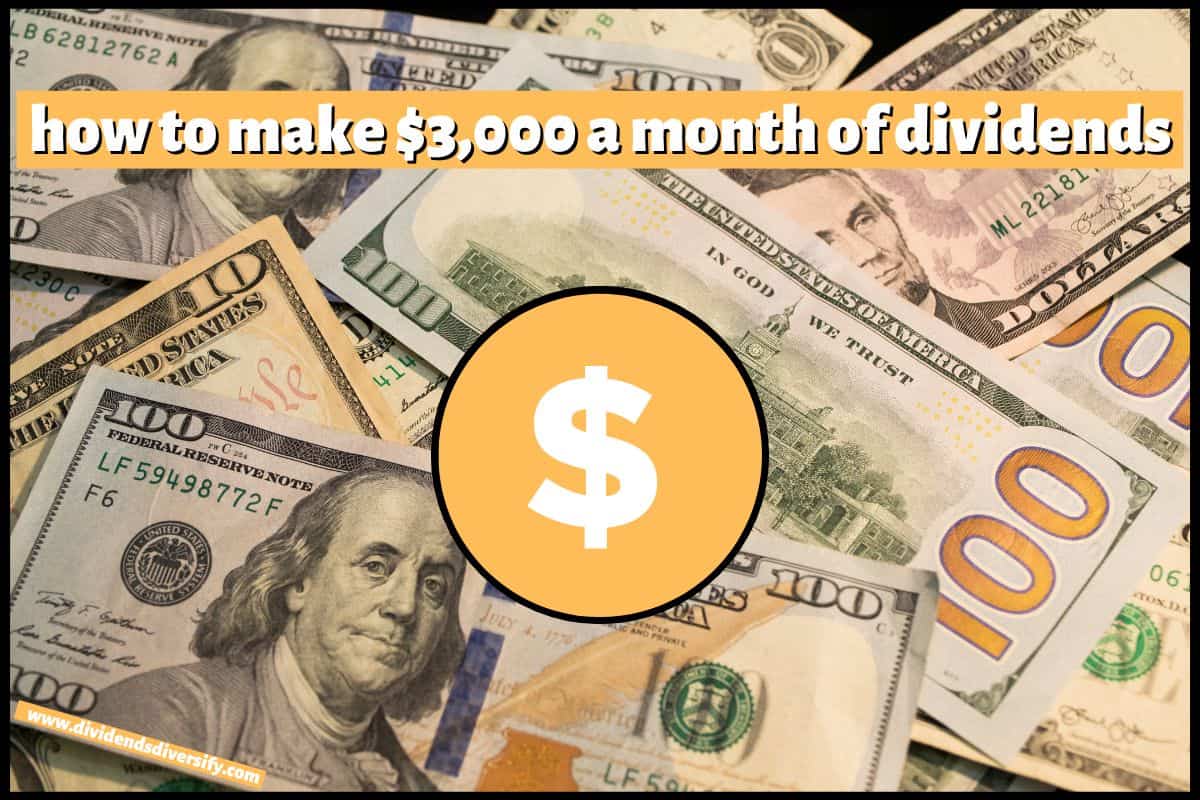Making Money Off Dividends Is Easier Than You Think
Today I will review the steps required, so you will know how to make $3,000 a month in dividends.
No delays. Let’s do it.
How to Make $3,000 a Month in Dividends
Successful long-term dividend investors follow these steps to earn consistent monthly dividend income:
- Start the journey
- Live on less and save the rest
- Pick quality dividend stocks
- Focus on quarterly dividend payers
- Invest money consistently
- Make portfolio adjustments
- Think long term
Next, please allow me to explain my thinking behind each one of these steps. And before wrapping up, I will address several frequently asked questions about making $3,000 a month in dividends.

Disclosure: At no cost to you, I may get commissions for purchases made through links in this post.
1. Start your dividend journey now to put as much time as possible on your side.
First off, let me emphasize that making $3,000 per month off dividends is a challenging goal.
Can you do it? Absolutely. You won’t be the first or last to do so.
It will take a long time for most people, so start now if you haven’t already. However, as time passes, your progress will accelerate as the magic of compounding dividends works wonders.
The great thing about dividend investing is that you only need several things to be successful:
- Time
- Money
- A brokerage account
- Good dividend stocks
If you still need to get a brokerage account, open one now. I like using the fast, powerful Webull app. You can open a Webull account here and, for a limited time, get free stock for doing so.
I will talk about good stocks that pay dividends in a moment, but first, let’s address the big elephant in the room, specifically, money.
2. Live below your means and put aside your savings.
It takes money to invest in dividend stocks. And unfortunately, there is no way to get around it.
I don’t care if it’s just $5 a day. And I don’t care how you do it. Thus, you must save money to invest in your dividend stocks and build your portfolio.
So, look at your budget and see where to reduce your expenses, for example:
- Work from home
- Brown bag lunch
- Eliminate a streaming service
- Reduce dining out
- Save on your online purchases
- Defer a purchase
- Get a side hustle
To sum up, make some lifestyle sacrifices to live below your means. And once you do, put aside the excess money in your brokerage account.
Furthermore, you may need an efficient tool to manage your spending, budget, and total financial picture. In that case, I recommend the money management app from Empower.
Okay, I have addressed time, money, and your brokerage account. Next, let’s talk dividend stocks.
3. Find, research, and pick high-quality dividend stocks.
I invest in stocks with long-term track records of paying rising dividends, also called dividend growth stocks. There are many ways to find and select good dividend-growth stocks. Here are my suggestions:
Pro-tip for step #3: Learn dividend investing basics.
First, learn as much as you can about dividend investing. I like the financial freedom investing course offered by Simply Investing.
The more you know, the better you get at picking your stocks. Whether you take the course or not, become familiar with essential dividend metrics like the following:
- The dividend yield
- Annual dividend rate per share
- The dividend payout ratio
Pro-tip for step #3: Develop a watch list of dividend stocks you would like to own.
Next, identify stocks with long and rich dividend payment histories. For this, I love the list of Dividend Kings and Dividend Aristocrats.
Kings and Aristocrats have paid uninterrupted dividends annually and have increased their dividend rates per share yearly for long periods.
Pro-tip for step #3: Learn what other dividend investors are doing and why.
Third, analyze what other dividend investors are doing with their investments. Figure out what stocks they hold and why.
There are several ways to go about looking at other investors’ stocks.
First, check out the stock holdings in the best dividend-paying index funds.
Find an investment buddy or join an investing club.
Finally, many dividend investors publish their holdings online. For example, you can check out the stocks in my dividend portfolio here.
Next, making $3,000 a month in dividends means you should pay attention to when your stocks pay their dividends.
So, let’s talk about timing up your dividend payments.
4. Focus on stocks that pay quarterly dividends.
To make $3,000 a month in dividends means you need a steady income stream. For this reason, some investors like monthly dividend stocks.
Not me. I recommend quarterly dividend stocks.
Why? Because the population of stocks paying quarterly dividends is much more significant. Having more choices means you can find the quality you are looking for and the diversification you need.
Most quarterly dividend stocks pay their dividends in the following months:
- January, April, July, and October dividend-paying stocks
- February, May, August, and November dividend payers
- March, June, September, and December dividend stocks
Thus, pick stocks from all the above three payment patterns to ensure a steady monthly income stream.
After you achieve your monthly dividend portfolio income goal, it’s unlikely that each month of the year will be exactly $3,000. However, if you mind your stock’s dividend payment patterns, you can get it reasonably close.
As a result, it’s better to think about making $36,000 a year from dividends rather than the monthly equivalent.
5. Invest your savings consistently in the dividend stocks of your choosing.
Okay. So far, you are living below your means, setting aside money, and have identified dividend stocks to buy.
Now you are ready for the following item in today’s guide about how to make $3,000 a month in dividends. Step 5 may be the easiest, investing in your chosen dividend stocks.
Pro-tip for step #5: Dollar Cost Average (DCA) into your dividends stocks
First, I recommend applying the dollar cost-averaging principle.
DCA means investing the same amount of dollars regularly into shares of stocks. Most investors choose a monthly or quarterly time frame.
Doing so makes you buy more shares when stock prices are lower. And fewer shares when stock market prices are higher.
Over the long run, implementing DCA will often achieve a lower average cost per share.
Pro-tip for step #5: Reinvest all dividends received.
Second, I recommend automatically reinvesting all dividends earned back into the stock that paid them.
By reinvesting your dividend income, you will quickly begin earning dividends on dividends. Doing so is part of building your dividend snowball that compounds your wealth over time.
6. Monitor and adjust your portfolio at least once a year.
Fortunately, dividend investors earn passive income. For example, there is little else to do after creating your list of stocks to buy and adding to your shares consistently.
However, I recommend periodically examining your annual dividend portfolio for monthly income. Please allow me to explain.
Pro-tip for step #6: Review each one of your dividends stocks.
First, look at each of your stocks and ask yourself some questions. After all, you bought each stock for one or more reasons.
So, do the original reasons for owning the stock still exist? Also, is the company still performing well?
If you answer no to either question, consider selling the stock and replacing it with a better option.
Pro-tip for step #6: Review your entire monthly dividend income portfolio.
Second, look at your dividend portfolio and ask yourself some additional questions.
First, am I adequately diversified among different types of businesses? For example, you should own stocks across a variety of dividend-paying sectors:
- Utilities
- Consumer staples
- Real estate investment trusts
- Financial services
- Business services
- Industrials
Do I own enough dividend stocks for diversification purposes? Is any one company becoming too big a piece of my portfolio?
Here’s the bottom line.
You want to own enough high-quality dividend stocks across various industries and avoid having any one stock become too large a piece of your portfolio.
Thus, adjust your portfolio when these things get out of line.
7. Think long-term, be patient, and stay invested.
Step 7 may be the most critical step of them all. Dividend investing is a long-term game. Thus, think of it as a journey, not a destination.
Understand that before making $3,000 a month in dividends, you will make $2,000.
Before making $2,000 a month in dividend income, you will make $1,000.
Before earning $1,000 a month, you will make $500 a month off dividend payments.
Each step in your journey is a reward. After all, would you scoff at making $500 a month off dividends? Well, I certainly hope not.
So, here’s my advice.
First, start now, get invested, and stay invested.
Second, be disciplined and add to your dividend portfolio every month. Furthermore, don’t sell in a panic when the stock market goes down (which it will).
The most successful dividend investors never sell. Instead, they strive to buy and hold forever, adjusting as they go.
Okay. There’s your 7-step guide to making $3,000 a month in dividends.
Next, I will address several relevant questions that may be on your mind.
How much money do you need to invest to make $3,000 a month in dividends?
You can figure on needing between $450,000 and $1,800,000 invested to earn $3,000 monthly in dividends. But, of course, your exact number will depend on your specific dividend investing strategy and your portfolio’s overall dividend yield.
However, understand that the amount required is lower than your out-of-pocket investment. For example, reinvested dividends, dividend increases, and share price appreciation will all contribute to the necessary amount.
Yes, it’s a ton of money. However, don’t throw up your arms and quick before you begin. Get started and first set your sights on $100 in monthly dividends.
How long does it take to make $3,000 a month in dividends?
The time it takes to make $3,000 a month in dividends depends on the amount you can invest regularly and the rate of return on your investments. Thus, each individual’s time frame to make $3,000 a month will differ.
Can you live off $3,000 a month in dividends?
Most families can not live off dividends of $3,000 per month. The average household income in the U.S. is about $70,000 annually. Thus, $3,000 a month in dividend income (or $36,000 annually) will only cover half the average U.S. family’s current earnings.
That’s it for today. Please allow me to wrap up with some concluding thoughts. But first, pin this image to your Pinterest money board so you can return later.

Wrap-Up: How to Make $3,000 a Month in Dividends in 7 Simple Steps
Dividends from dividend growth investing and the dividend stocks that pay them are excellent investment alternatives. Supplement your income and participate in long-term stock market gains as you take control of your retirement plans and financial future.
Finally, visit my article archives for more information about dividend investing and building dividend stock portfolios.

Author Bio: Tom Scott founded the consulting and coaching firm Dividends Diversify, LLC. He leverages his expertise and decades of experience in goal setting, relocation assistance, and investing for long-term wealth to help clients reach their full potential.